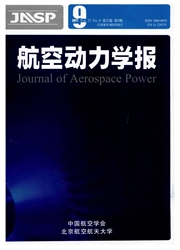

 中文摘要:
中文摘要:
针对低展弦比涡轮叶栅端壁区亚声速流动及换热,采用基于线性涡黏假设的V2F模型开展了数值模拟.结果表明:涡轮叶栅流动中存在马蹄涡、通道涡、压力侧角涡、吸力侧角涡等多种复杂涡系结构,其中马蹄涡与通道涡是涡轮叶栅二次损失的主要来源.端壁换热与马蹄涡及通道涡强度及位置直接相关,并呈现明显的分区特征.端壁极限流线结果显示,V2F模型模拟的端壁单马蹄涡分离线与实验结果吻合,优于SST(shear stress transport)k-ω模型模拟的端壁双马蹄涡分离线.V2F模型引入了新的湍流尺度,在马蹄涡及通道涡位置、端壁静压损失系数分布、叶栅出口总压损失分布及端壁Standon数分布等方面均与实验结果吻合较好,对叶栅气动损失及端壁换热有良好的预测能力.
 英文摘要:
英文摘要:
Numerical simulation using V2F model based on a linear eddy viscosity assumption, was carried out on subsonic flow and heat transfer of turbine cascade endwall with low aspect ratio airfoil. The results show that complex vortex structures in turbine cascade are mainly composed of horseshoe vortex, passage vortex, pressure side corner vortex and suction side corner vortex. The horseshoe vortex and passage vortex are main sources of secondary loss, and their intensity and location have direct effect on heat transfer of endwall, showing obvious partition property; prediction on endwall limiting streamlines shows that single horseshoe vortex separation line with V2F model is consistent with the experiment da- ta, and superior to double horseshoe vortex separation line predicted by SST (shear stress transport) k-ω model. With introduction of a new turbulent scale, which coincides well with experiment data on endwall static pressure loss coefficient distribution, locations of horse-shoe vortex and passage vortex and total pressure loss coefficient distribution of cascade outlet and endwall Standon number distribution, V2F model could predict better on both cascade aerodynamic loss and endwall heat transfer than SST k-ωmodel.
 同期刊论文项目
同期刊论文项目
 同项目期刊论文
同项目期刊论文
 期刊信息
期刊信息
